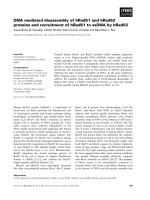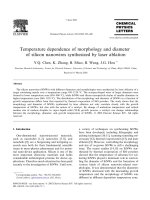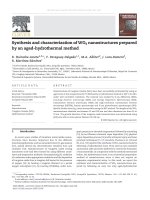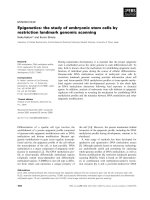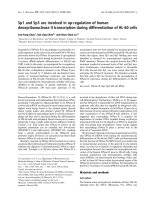Augmentation and differentiation of hematopoietic progenitor cells by CD137
Bạn đang xem bản rút gọn của tài liệu. Xem và tải ngay bản đầy đủ của tài liệu tại đây (5.08 MB, 210 trang )
AUGMENTATION AND DIFFERENTIATION OF
HEMATOPOIETIC PROGENITOR CELLS BY CD137
JIANG DONGSHENG
(B.Sc (Hons), NUS)
A THESIS SUBMITTED FOR THE DEGREE OF
DOCTOR OF PHILOSOPHY
DEPARTMENT OF PHYSIOLOGY
YONG LOO LIN SCHOOL OF MEDICINE
NATIONAL UNIVERSITY OF SINGAPORE
2009
ii
ACKNOWLEDGEMENTS
I would first like to express my heartfelt gratitude to my supervisor, A/P Herbert
Schwarz, for his invaluable guidance throughout the course of this project. I truly
appreciate his unreserved encouragement and support, irradiative advice and critiques,
and remarkable patience.
Special thanks to the following people for their help with my work: Dr. Sylvie Alonso
and Dr. Seah Geok Teng for their initiative discussions and suggestions; Ariel and Poh
Cheng for guiding me when I first joined the lab; Sun Feng and Doddy for helping me
with the immunohistochemistry and radioactive work; Richard for the influenza A
infection in C57BL/6 mice; Aakansha for the Bordetella pertussis infection in
BALB/c mice; and Isabel and Eunice for teaching and helping me during the first year
of my study.
I am also grateful to all the current and previous members in my lab, including Shao
Zhe, Jane, Shaqireen, Elaine, Liang Kai, Sharon, Diana, Jeanette, Dr. Yan, Dipanjan,
Wen Tong, Kok Leng, Shi Hao, Mira, and Qianqiao. With whom I have shared four
cherished years in such a comfortable environment. This wonderful experience is a
priceless treasure in my life.
I also would like to express my appreciation to the General Offices of Department of
iii
Physiology and Immunology Program for their generous support.
Last but not least, I would like to thank my parents for their constant love and support.
iv
TABLE OF CONTENTS
ACKNOWLEDGEMENT
ii
TABLE OF CONTENT
iv
ABSTRACT
x
LIST OF TABLES
xi
LIST OF FIGURES
xii
LIST OF ABBREVIATIONS
xvi
CHAPTER 1 INTRODUCTION
1
1.1 Hematopoietic stem and progenitor cells (HSPC)
1
1.2 Hematopoiesis and myeloid cells
3
1.2.1 Overview of hematopoiesis
3
1.2.2 Monocytes / Macrophages
5
1.2.3 Myeloid dendritic cell
8
1.2.4 Granulocytes
9
1.2.5 Myeloid derived suppressor cells
10
1.3 CD137
11
1.3.1 Expression of CD137
11
1.3.2 Structure of CD137
12
1.3.3 Biological functions of CD137
15
1.3.4 Diseases associated with CD137
17
1.4 CD137 ligand
18
1.4.1 Expression of CD137 ligand
18
1.4.2 Structure of CD137L
19
1.4.3 Bidirectional signaling of CD137 receptor / ligand system
21
1.4.4 Biological functions of reverse signaling through CD137L
21
1.4.4.1 Reverse signaling through CD137L in monocytes
22
1.4.4.2 Reverse signaling through CD137L in DCs
23
1.4.4.3 Reverse signaling through CD137L in B cells
24
v
1.4.4.4 Reverse signaling through CD137L in bone marrow cells
25
1.4.4.5 Reverse signaling through CD137L in T cells
26
1.5 Scope and objectives of the study
29
CHAPTER 2 MATERIALS AND METHODS
2.1 Preparations of animal and human samples
30
2.1.1 Mice
30
2.1.2 Preparation of bone marrow cells and splenocytes
30
2.1.3 Isolation of Lin
-
, CD117
+
and Gr-1
+
cells from mouse bone
marrow cells
31
2.1.4 Isolation of pan T cells from mouse splenocytes
32
2.1.5 Isolation of CD34
+
cells and monocytes from human cord blood
32
2.1.6 Intra-peritoneal (i.p.) injection of LPS
33
2.1.7 Adoptive transfer of T cells
34
2.2 Molecular and biochemical techniques
35
2.2.1 Recombinant proteins and chemicals
35
2.2.2 RT-PCR
36
2.3 Cell biology techniques
36
2.3.1 Coating of recombinant proteins and antibodies
36
2.3.2 Cell count
37
2.3.2.1 Manual cell count with Trypan blue
37
2.3.2.2 Differential Cell Count
37
2.3.2.3 Cell count by FACS with counting beads
38
2.3.3 Flow cytometry analysis and antibodies
38
2.3.4 CFSE labeling
39
2.3.5 Proliferation assay
39
2.3.6 Colony-forming assay
40
2.3.6.1 Colony-forming assay for mouse bone marrow and
Lin
-
,CD117
+
cells
40
vi
2.3.6.2 Colony-forming assay for human CD34
+
cells
40
2.3.7 Apoptosis assay
41
2.3.8 Phagocytosis assay
41
2.3.8.1 Phagocytosis assay for mouse bone marrow cells and Lin
-
,
CD117
+
cells
41
2.3.8.2 Phagocytosis assay for human cord blood CD34
+
cells and
monocytes
42
2.3.9 Allogeneic mixed lymphocyte reaction
42
2.3.9.1 Allogeneic MLR for mouse Lin
-
, CD117
+
cells
42
2.3.9.2 Allogeneic MLR for human cord blood CD34
+
cells and
monocytes
43
2.3.9.3 MLR for suppressor cell function
43
2.3.10 ELISA
44
2.3.11 Transfection
45
2.3.12 Cytokine antibody array
45
2.3.13 Cytometric bead array
46
2.3.14 Microscopy and photography
47
2.4 Staining procedures
47
2.4.1 Immunocytochemistry
47
2.4.2 Immunohistochemistry
47
2.4.3 Esterase stain
48
2.5 Statistics
48
CHAPTER 3 RESULTS
49
3.1 Induction of proliferation and monocytic differentiation of human
CD34
+
cells by CD137L signaling
49
3.1.1 CD137 and its ligand are expressed in the bone marrow
49
3.1.2 CD137 induces morphological changes of CD34
+
cells
51
3.1.3 CD137 induces proliferation of CD34
+
cells
53
vii
3.1.4 CD137 induces colony formation of CD34
+
cells
56
3.1.5 CD137 ligand signaling induces differentiation towards the
myeloid lineage
57
3.1.6 CD137 induces differentiation to macrophages
61
3.1.7 Maintenance of cell survival and induction of cell proliferation on
CD34
+
cells by CD137 were partially dependent on IL-8 and cell
density
70
3.1.8 CD137 is unable to induce the proliferation of DCs
74
3.2 CD137 induces proliferation of murine hematopoietic progenitor cells
and differentiation to macrophages
78
3.2.1 CD137 ligand signaling regulates survival and proliferation of
murine bone marrow cells
78
3.2.2 CD137 ligand signaling changes the morphology of murine bone
marrow cells and Lin
-
, CD117
+
cells
83
3.2.3 CD137 ligand signaling induces colony formation in
hematopoietic progenitor cells
87
3.2.4 Expression of CD137 and CD137 ligand on bone marrow cells
91
3.2.5 Murine CD137 elicits same effects as human CD137 on murine
bone marrow cells
93
3.2.6 CD137 ligand signaling induces differentiation to monocytic cells
96
3.2.7 CD137 ligand signaling induces macrophage differentiation
104
3.2.8 Macrophages induced by CD137L signaling are immune
suppressive
110
3.2.9 CD137 does not induce proliferation of murine embryonic stem
cells
112
3.3 G-CSF and CD137 cooperatively induce proliferation of bone marrow
cells but antagonize each other in promoting granulocytic or monocytic
differentiation
114
3.3.1 CD137 ligand signaling in bone marrow cells leads to an increase
114
viii
in myeloid cell numbers except granulocyte numbers
3.3.2 CD137 does not induce apoptosis of bone marrow granulocytes
114
3.3.3 G-CSF and CD137 cooperatively induce survival and proliferation
and morphological changes of bone marrow cells
118
3.3.4 CD137 and G-CSF antagonize each other in inducing
differentiation of bone marrow cells
120
3.4 CD137 supports Flt3L induced bone marrow derived monocytic DC
differentiation
128
3.4.1 CD137 and Flt3L cooperatively induce morphological changes,
survival and proliferation of murine bone marrow cells
128
3.4.2 CD137 supports Flt3L induced MoDC differentiation from bone
marrow cells
130
3.4.3 CD137 does not further enhance Flt3L induced proliferation and
differentiation of HSPCs
132
3.5 CD137 expression is positively regulated during infection
134
3.5.1 Bone marrow stromal cells may not be the source of CD137 in the
bone marrow
134
3.5.2 Bacterial Bordetella pertussis infection increases the number of
CD137
+
cells in the bone marrow
136
3.5.3 Virus Influenza A (H1N1) infection increases number of CD137
+
cells in the bone marrow
139
3.5.4 I.p. injected LPS increases the number of CD137
+
cells in the bone
marrow
140
3.5.5 CD137 expressed on activated T cells can induce proliferation of
bone marrow cells
142
CHAPTER 4 DISCUSSION
145
4.1 What have we learned about the role of CD137L signaling in
hematopoiesis?
145
ix
4.2 Into what lineage does CD137 drive differentiation of HSPCs?
147
4.3 Is CD137 a general growth factor and activator for monocytic cells?
150
4.4 Are CD137
+
bone marrow cells T cells?
151
4.5 Does CD137L signaling influence myelopoiesis differently during
steady state conditions and during immune responses?
155
4.5.1 CD137 induces myelopoiesis during infection
155
4.5.2 CD137 limits myelopoiesis and the development of DCs at steady
state
157
4.6 Are HSPCs differentiated by CD137 regulatory macrophages or MDSC?
159
4.7 Is CD137-induced myelopoiesis beneficial or deleterious for the host?
162
4.8 At what differentiation stage do HSPCs respond to CD137?
164
4.9 How can a small population of CD137 and CD137L expressing cells in
bone marrow cause such wide-spread functional effects?
166
4.10 Future studies
168
CHAPTER 5 CONCLUSION
172
REFERENCES
173
APPENDICES
188
Appendix I. Buffers and Solutions
188
Appendix II. List of antibodies used in the study
189
Appendix III. Primers and cycling conditions for RT-PCR
191
Appendix IV. The antibody list and the map of cytokine antibody array
192
Appendix V. Publications
193
x
ABSTRACT
CD137 is a member of the TNF receptor family, and is involved in the regulation of
activation, proliferation, differentiation and cell death of leukocytes. Bidirectional
signaling exists for the CD137 receptor / ligand system as CD137 ligand which is
expressed as a transmembrane protein, can also transduce signals into the cells it is
expressed on. In this study we have identified the expression of CD137 and CD137
ligand on small subsets of bone marrow cells. Activation of hematopoietic progenitor
cells – CD34
+
cells in the human system and Lin
-
, CD117
+
cells in the murine system
– through CD137 ligand induces activation, prolongation of survival, proliferation and
colony formation. Concomitantly to proliferation, the cells differentiate to colony
forming units granulocyte macrophage (CFU-GM), and then to monocytes and
macrophages but not to granulocytes or dendritic cells. Hematopoietic progenitor cells
differentiated in the presence of CD137 protein display enhanced phagocytic activity,
secrete high levels of IL-10 but no IL-12 in response to LPS, and can partially
suppress T cell activation and proliferation in an allogeneic mixed lymphocyte
reaction. CD137 and G-CSF cooperatively induce survival and proliferation of murine
bone marrow cells, while they compete for inducing monocytic and granulocytic
differentiation, respectively. The number of CD137
+
cells in the bone marrow is
positively regulated during infection and inflammation. These data uncover a novel
function of CD137 and CD137 ligand by showing their participation in hematopoiesis,
in particular, myelopoiesis and monocytosis.
xi
LIST OF TABLES
Table 1
Structure features of human CD137 protein.
14
Table 2
Biological functions of reverse signaling through CD137L in
hematopoietic cells.
28
Table 3
Differential cytokine profiles between CD137-Fc- and Fc-treated
bone marrow cells on day 7 detected by cytokine antibody array.
109
Table 4
CD137 expression on AA101 cells is proportional to the cell density.
136
xii
LIST OF FIGURES
Figure 1.1
Overview of hematopoiesis and the role of cytokines in vivo.
4
Figure 1.2
Classification of macrophage populations.
8
Figure 1.3
Schematic diagram of the structure of murine and human CD137 mRNA and protein.
13
Figure 1.4
Schematic diagram of the structure of murine and human CD137L mRNA and protein.
20
Figure 1.5
Schematic diagram of bidirectional signal transduction of the CD137 receptor / ligand system.
21
Figure 2.1
Schematic diagram of the structure of recombinant CD137-Fc protein.
35
Figure 2.2
Schematic diagram of coating proteins or antibodies onto the tissue culture plates.
37
Figure 3.1
CD137 and CD137L expression.
50
Figure 3.2
CD137 induces morphological changes of CD34
+
cells.
52
Figure 3.3
CD137 maintains survival and induces proliferation of CD34
+
cells.
54
Figure 3.4
CD137L agonists immobilized on beads induce proliferation of CD34
+
cells.
55
Figure 3.5
CD137L signaling promotes colony formation.
57
Figure 3.6
Flow cytometric analysis of CD137-induced differentiation of CD34
+
cells.
60
Figure 3.7
Morphological comparison of CD137 differentiated cells, DCs and macrophages.
63
Figure 3.8
RT-PCR of macrophage- and DC-specific genes.
64
Figure 3.9
Flow cytometric analysis of DC / macrophage cell surface marker expression on CD137-treated cells.
67
xiii
Figure 3.10
Phagocytic function analysis.
68
Figure 3.11
IL-10 and IL-12p70 ELISA.
69
Figure 3.12
MLR.
70
Figure 3.13
IL-8 ELISA.
71
Figure 3.14
CD137-induced survival and proliferation of CD34
+
cells are partially dependent on IL-8.
73
Figure 3.15
CD137-induced proliferation of CD34
+
cells increases exponentially with the increasing initial cell density.
74
Figure 3.16
CD137 is unable to induce proliferation of human MoDCs.
76
Figure 3.17
CD137L crosslinking increases cell numbers of murine bone marrow cells.
79
Figure 3.18
CD137L crosslinking induces proliferation of bone marrow cells.
80
Figure 3.19
CD137L crosslinking induces proliferation of Lin
-
, CD117
+
cells.
82
Figure 3.20
Tracking of cell division.
83
Figure 3.21
Morphological changes induced by CD137 protein.
85
Figure 3.22
Colony formation from bone marrow cells in response to CD137.
87
Figure 3.23
Colony formation from Lin
-
, CD117
+
cells in response to CD137.
89
Figure 3.24
Effect of neutralizing anti-GM-CSF antibody on CD137-induced morphological changes, proliferation, and colony
formation.
90
Figure 3.25
Expression of CD137 and CD137L in the bone marrow.
92
xiv
Figure 3.26
Functional equivalence of human and murine CD137.
94
Figure 3.27
CD137L signaling induces differentiation of bone marrow cells to monocytic cells.
99
Figure 3.28
CD137L signaling induces differentiation of Lin
-
, CD117
+
cells to monocytic cells.
103
Figure 3.29
Phagocytosis assay.
105
Figure 3.30
Allogeneic MLR.
107
Figure 3.31
ELISA of IL-10 and IL-12p70.
108
Figure 3.32
Cytokine profile.
109
Figure 3.33
CD137-induced Lin
-
, CD117
+
macrophages partially suppress T cell proliferation in an allogeneic MLR.
111
Figure 3.34
CD137 does not induce proliferation of mouse ES cells.
113
Figure 3.35
CD137 does not induce apoptosis of bone marrow granulocytes.
116
Figure 3.36
Ethidium bromide and acridine orange staining.
117
Figure 3.37
G-CSF and CD137 synergizes to induce proliferation and survival of bone marrow cells.
118
Figure 3.38
Cell morphology.
119
Figure 3.39
G-CSF and CD137 compete for inducing granulocytic and monocytic differentiation, respectively.
122
Figure 3.40
Dose response of the combination of G-CSF and CD137 protein.
125
Figure 3.41
Esterase staining.
126
Figure 3.42
CD137 and Flt3L cooperatively induce morphological changes of bone marrow cells.
129
xv
Figure 3.43
Flt3L and CD137 additively induce survival and proliferation of bone marrow cells.
130
Figure 3.44
CD137 supports Flt3L induced bone marrow derived DCs differentiation.
131
Figure 3.45
CD137 shows no additive effect with Flt3L on Lin
-
,
CD117
+
cells.
132
Figure 3.46
AA101 cells express CD137 and CD137L.
134
Figure 3.47
ST-2 and MS-5 cells express neither CD137 nor CD137L.
136
Figure 3.48
B. pertussis infection leads to an increase of CD137
+
cells in the bone marrow.
138
Figure 3.49
Influenza A infection leads to an increase of CD137
+
cells in the bone marrow.
139
Figure 3.50
I.p. injection of LPS leads to an increase of CD137
+
cells in the bone marrow.
141
Figure 3.51
Activated T cells could induce bone marrow cell proliferation.
143
Figure 4.1
Proposed schematic summary of CD137-induced myelopoiesis.
151
xvi
LIST OF ABBREVIATIONS
APC Antigen presenting cells
BM Bone marrow
bp Base pair
CBA Cytokine beads array
CD137L CD137 ligand
CFSE Carboxyfluorescein diacetate, succinimidyl ester
CFU-G Colony forming unit-granulocyte
CFU-GM Colony forming unit-granulocyte/macrophage
CFU-M Colony forming unit-macrophage
CPM Count per minute
CMP Common myeloid progenitors
DC Dendritic cells
EDTA Ethylenediamine tetraacetic acid
ELISA Enzyme-linked immunosorbent assay
EPO Erythropoietin
ES Embryonic stem
FACS Fluorescence activated cell sorting
Fc Fc portion of an antibody
FITC Fluorescein isothiocyanate
Flt3L Fms-like tyrosine kinase 3 (Flt3) ligand
G-CSF Granulocyte colony stimulating factor
GM-CSF Granulocyte macrophage colony stimulating factor
GMP Granulocyte macrophage progenitors
HPC Hematopoietic progenitor cells
HRP Horseradish peroxidase
HSC Hematopoietic stem cells
HSPC Hematopoietic stem / progenitor cells
ICC Immunocytochemistry
IFN Interferon
IHC Immunohistochemstry
IL Interleukin
ILA Induced by lymphocyte activation
i.p. Intra-peritoneal
IRB Institutional review board
i.v. Intra-venous
KC Keratinocyte cytokine
KO Knockout
LIF Leukemia inhibitory factor
LPS Lipopolysaccarides
mAb Monoclonal antibody
MACS Magnetic activated cell sorting
xvii
mCD137-Fc Murine CD137-Fc
MCP-1 Monocyte chemoattractant protein-1
M-CSF Monocyte colony stimulating factor
MDSC Myeloid derived suppressor cells
MoDC Monocyte derived dendritic cells
MFI Mean fluorescence intensity
MLR Mixed lymphocyte reaction
NK Natural killer
PBMC Peripheral blood mononuclear cells
PBS Phosphate buffered saline
PBST PBS + 0.05% Tween-20
PE Phycoerythrin
PFA Paraformaldehyde
RBC Red blood cells
RT-PCR Reverse transcription – polymerase chain reaction
SCF Stem cell factor
SD Standard deviation
SE Standard error
TAE Tris-acetate-EDTA
TAM Tumor associated macrophages
TECK Thymus-expressed chemokine
TNF Tumor necrosis factor
TNFR Tumor necrosis factor receptor
TPO Thrombopoietin
WT Wide type
1
CHAPTER 1 INTRODUCTION
1.1 Hematopoietic stem and progenitor cells (HSPC)
Stem cells hold great promise for regenerative medicine and the study of cell and
tissue differentiation. Hematopoietic stem and progenitor cells (HSPC) are to date the
best-studied stem cell population, and are already used for several clinical
applications.
First, HSPCs are an indispensable source of replenishment of blood and immune cells.
All adult hematopoietic lineages are derived from very small numbers of
self-replicating hematopoietic stem cells (HSC). This breathtaking ability to
reconstitute the hematopoietic system makes transplantation of HSPCs after ablative
chemotherapy the gold standard of care for treatment of leukaemia and lymphoma
nowadays. These chemotherapy and radiation therapies inevitably destroy actively
dividing healthy cells of the hematopoietic system along with the cancer cells.
Patients thus often become immune deficient and highly susceptible to opportunistic
infections which may even be fatal. The traditional treatment regiment involves the
use of granulocyte colony-stimulating factor (G-CSF / Neupogen), but the short half
life of this factor demands for daily injections. Furthermore, this treatment is specific
for the augmentation of granulocytes. HSPCs with their multipotential seem to offer a
better alternative solution for shortening the period of profound pancytopenia
following chemotherapy or chemo-radiotherapy. This may in turn lessen the chances
2
of opportunistic infections and improve the patients' quality of life. Engraftment of
HSPCs to cancer patients following chemotherapy also means that patients can be
treated more aggressively, thereby increasing the potential for complete remission
(Elias, 1995). Therefore, in the recent decade, transplantation of HSPCs have been
more frequently used in autologous and allogeneic settings to restore the immune
functions (Corringham and Ho, 1995; Sorrentino, 2004; Heike et al., 2002).
More recently, there are emerging clinical applications of HSPCs for other malignant
and non-malignant diseases. For example, HSPCs are capable of trans-differentiation
to non-hematopoietic tissues to replace damaged or lost tissues (Orlic et al., 2001;
Bailey et al., 2004). Recent cardiac clinical trials of introducing autologous
hematopoietic progenitor cells during coronary artery bypass grafting demonstrated
that patients had significantly improved circulation into infarct area and cardiac
functions (Stamm et al., 2003). Clinical applications for hematopoietic progenitor
cells are therefore no longer restricted to hematopoietic and immune reconstitution.
This enormous clinical potential of HSPCs is, however, limited by their low
availability. It is therefore of great importance to find ways to effectively and
efficiently amplify the numbers of these cells. Hematopoietic growth factors and
cocktails of such factors are an essential part of the ex vivo or in vivo amplification
protocols of HSPCs. Unfortunately, the effective expansion of HSPCs has yet to be
attained in spite of over 20 years of research in animal models and human clinical
3
trials (Devine et al., 2003).
1.2 Hematopoiesis and myeloid cells
1.2.1 Overview of hematopoiesis
Hematopoiesis is a complex and tightly regulated process, and is essential for the
homeostasis of tissue oxygenation and immune functions. Deepening our
understanding of the regulation and mechanisms of hematopoiesis is expected to
continue to offer new and effective therapies.
Hematopoiesis (Fig. 1.1) starts with HSCs, cells that can renew themselves and can
differentiate to a variety of specialized cells. HSCs can be further divided into three
groups, long term (LT)-HSC, short term (ST)-HSC and multi-potential progenitor
(MPP). LT-HSCs are very rare and usually in a quiescent state, while MPPs are in a
more active state. The MPPs commit to common myeloid progenitors (CMP) in the
presence of stem cell factor (SCF) and thrombopoietin (TPO), or to common
lymphoid progenitors (CLP) in the presence of IL-7. (Robb, 2007).
CMPs further differentiate to megakaryocyte erythroid progenitors (MEP) or
granulocyte-macrophage progenitors (GMP). MEPs give rise to megakaryocytes
(platelets) under the influence of TPO, or erythrocytes (red blood cells) under the
influence of erythropoietin (EPO) (Robb, 2007). GMPs have potential to give rise to
4
monocytes, which further differentiate to macrophages or myeloid DCs in the
peripheral tissues depending on the microenvironment; or to granulocytes, including
neutrophils, eosinophils and basophils. This process is called myelopoiesis, and
colony stimulating factors, such as GM-CSF, G-CSF and M-CSF, are crucial
regulators of myelopoiesis (Fig. 1.1).
CLPs undergo lymphopoiesis and give rise to B cells, T cells and NK cells, depending
on the presence of various interleukins as shown in Fig. 1.1. (Robb, 2007).
Figure 1.1. Overview of hematopoiesis and the role of cytokines in vivo. HSC,
hematopoietic stem cells; CMP, common myeloid progenitor; CLP, common
lymphoid progenitor; MEP, megakaryocyte erythroid progenitor; GMP,
granulocyte-macrophage progenitor; MkP, megakaryocyte progenitor; EP, erythroid
5
progenitor; TNK, T-cell natural killer cell progenitor; BCP, B-cell progenitor. IL,
interleukin; SCF, stem cell factor; TPO, thrombopoietin; EPO, erythropoietin;
GM-CSF, granulocyte-macrophage-colony stimulating factor; G-CSF,
granulocyte-colony stimulating factor; M-CSF, macrophage-colony stimulating factor.
(Robb, 2007).
1.2.2 Monocytes / Macrophages
Macrophages have long been considered to be important immune effector cells. 100
years ago (1908), Elie Metchnikoff who won the Nobel Prize for his description of
phagocytosis, proposed that the key to immunity was to “stimulate the phagocytes”
(Gordon, 2008). Macrophages are present in virtually all tissues. During monocyte
development, GMPs sequentially give rise to monoblasts, pro-monocytes and finally
monocytes, which are released from the bone marrow into the bloodstream.
Monocytes migrate from the blood into tissues to replenish long-lived tissue-specific
macrophages of the bone (osteoclasts), alveoli, central nervous system (microglial
cells), connective tissue (histiocytes), gastrointestinal tract, liver (Kupffer cells),
spleen and peritoneum (Gordon and Taylor, 2005).
In innate immunity, resident macrophages provide immediate defense against foreign
pathogens and coordinate leukocyte infiltration (Martinez et al., 2008). Macrophages
contribute to the balance between antigen availability and clearance through
phagocytosis and subsequent degradation of apoptotic cells, microbes and possibly
neoplastic cells (Gordon, 2003). In adaptive immunity, macrophages collaborate with
T and B cells, through both cell-to-cell interactions and fluid phase-mediated
6
mechanisms, based on the release of cytokines, chemokines, enzymes, arachidonic
acid metabolites, and reactive radicals (Gordon, 2003; Martinez et al., 2008).
Macrophages display remarkable plasticity and can change their physiology in
response to environmental cues. These changes can give rise to different populations
of cells with distinct functions. Now, it is commonly accepted that activated
macrophages can be classified into two main groups (Fig. 1.2 A): classically activated
macrophages (or M1), whose prototypical activating stimuli are IFN-γ and LPS; and
alternatively activated macrophages (or M2), further subdivided into M2a (after
exposure to IL-4 or IL-13), M2b (immune complexes in combination with IL-1β or
LPS) and M2c (IL-10, TGF-β or glucocorticoids) (Martinez et al, 2008). M1
macrophages exhibits potent microbicidal properties and promote strong
IL-12-mediated Th1 responses, whilst M2 macrophages support Th2-associated
effector functions. Beyond infection, M2-polarized macrophages play a role in the
resolution of inflammation through high endocytic clearance capacities and trophic
factor synthesis, accompanied by reduced pro-inflammatory cytokine secretion
(Martinez et al, 2008). In the tumor microenvironment, M2 macrophages could be
redirected to tumor-associated macrophages (TAM), which are believed to facilitate
tumor growth, angiogenesis and metastasis by secreting various growth factors and
suppressing the anti-tumor immune responses (Bingle et al., 2002; Lin and Pollard,
2004).
7
More recently, a new grouping of macrophage populations has been suggested, based
on the three different homeostatic activities – host defense, would healing and
immune regulation (Fig. 1.2 B) (Mosser and Edwards, 2008). It is proposed that
similarly to primary colors these three basic macrophage populations can blend into
various other “shades” of activation. Compared to the linear polar classification of M1
/ M2, this classification better illustrates how macrophages can evolve to exhibit
characteristics that are shared by more than one macrophage population. The concept
of “regulatory macrophages” is raised in this new classification. Regulatory
macrophages, which are anti-inflammatory, can arise following innate or adaptive
immune responses. This population of macrophages produces high levels of the
immunosuppressive cytokine IL-10, and also downregulates IL-12 production (Gerber
and Mosser, 2001). Therefore, the ratio of IL-10 to IL-12 could be used to define
regulatory macrophages. Unlike wound-healing macrophages, these regulatory
macrophages do not contribute to the production of extracellular matrix, and many of
these regulatory cells express high levels of costimulatory molecules (CD80 and
CD86) and therefore can present antigens to T cells (Edwards et al., 2006). So, there
are clear functional, as well as biochemical differences between regulatory and
wound-healing macrophages.
8
Figure 1.2. Classification of macrophage populations. (A) A monochromatic
depiction of the nomenclature showing the linear scale of the two macrophage
designations, M1 and M2. (B) The three populations of macrophages that are
classified based on the three different homeostatic activities – classically activated
macrophages, would-healing macrophages, and regulatory macrophages. (Mosser and
Edwards, 2008).
1.2.3 Myeloid dendritic cells
Dendritic cells (DCs), the so-called “conductor of the immune orchestra”, are
professional antigen presenting cells (APCs) endowed with the unique
capacity to
activate naive T cells. DCs also have important effector
functions during innate
immune responses, such as pathogen
recognition and cytokine production. Therefore,
DCs are a bridge between innate and adaptive immunity.
Similar as monocytes and macrophages, bone marrow derived myeloid DCs (also
called conventional DCs) consist of a complex and heterogeneous population of cells

